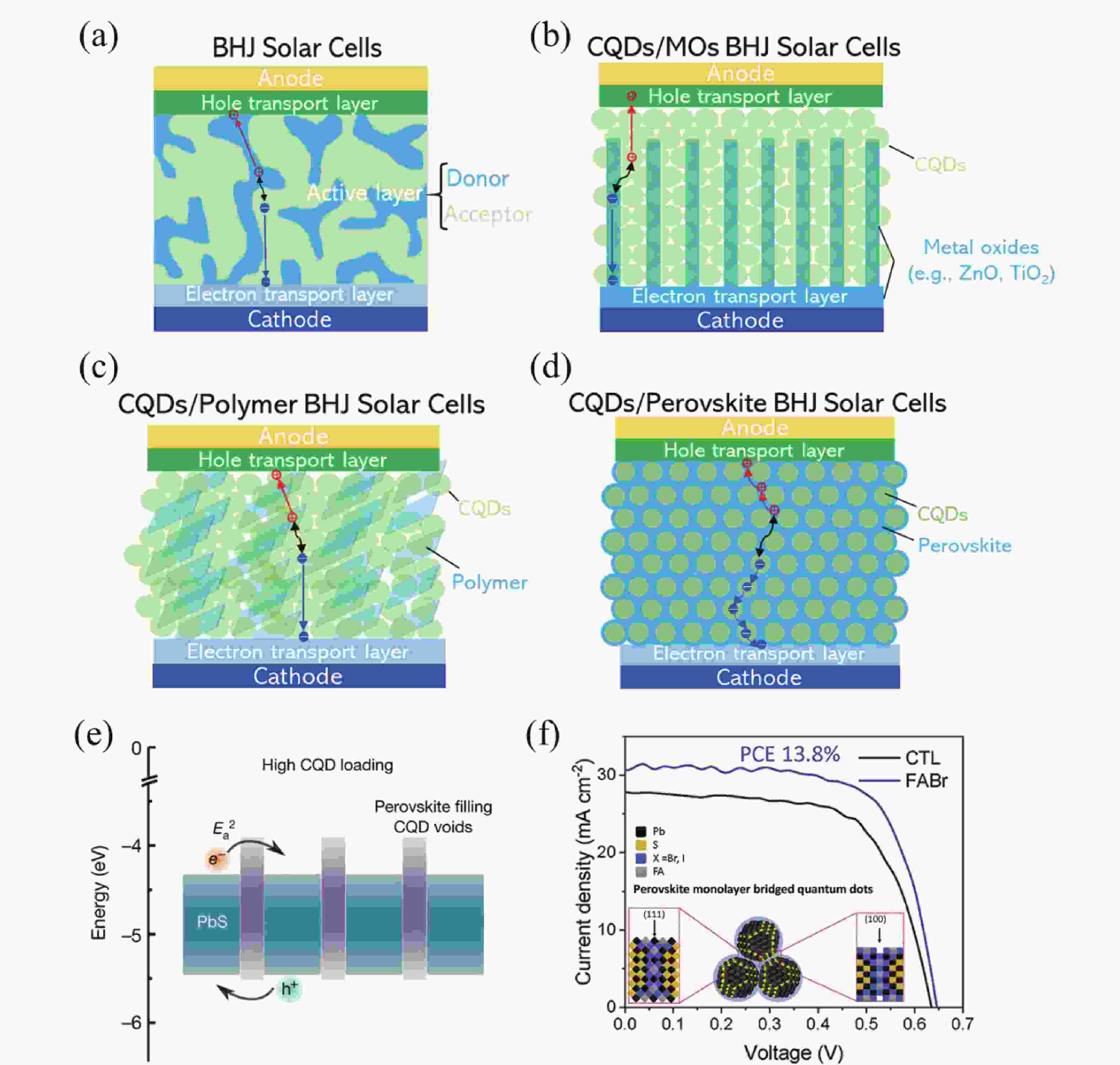| Citation: |
Chao Ding, Lixiu Zhang, Qing Shen, Liming Ding. Colloidal quantum-dot bulk-heterojunction solar cells[J]. Journal of Semiconductors, 2021, 42(11): 110203. doi: 10.1088/1674-4926/42/11/110203
C Ding, L X Zhang, Q Shen, L M Ding, Colloidal quantum-dot bulk-heterojunction solar cells[J]. J. Semicond., 2021, 42(11): 110203. doi: 10.1088/1674-4926/42/11/110203.
Export: BibTex EndNote
|
Colloidal quantum-dot bulk-heterojunction solar cells
doi: 10.1088/1674-4926/42/11/110203
More Information-
References
[1] Ding C, Liu F, Zhang Y, et al. Passivation strategy of reducing both electron and hole trap states for achieving high-efficiency PbS quantum-dot solar cells with power conversion efficiency over 12%. ACS Energy Lett, 2020, 5, 3224 doi: 10.1021/acsenergylett.0c01561[2] Shi G Z, Wang Y J, Liu Z K, et al. Stable and highly efficient PbS quantum dot tandem solar cells employing a rationally designed recombination layer. Adv Energy Mater, 2017, 7, 1602667 doi: 10.1002/aenm.201602667[3] Zhou W, Shang Y, García de Arquer F P, et al. Solution-processed upconversion photodetectors based on quantum dots. Nat Electron, 2020, 3, 251 doi: 10.1038/s41928-020-0388-x[4] McDonald S A, Konstantatos G, Zhang S, et al. Solution-processed PbS quantum dot infrared photodetectors and photovoltaics. Nat Mater, 2005, 4, 138 doi: 10.1038/nmat1299[5] Sun B, Johnston A, Xu C, et al. Monolayer perovskite bridges enable strong quantum dot coupling for efficient solar cells. Joule, 2020, 4, 1542 doi: 10.1016/j.joule.2020.05.011[6] Lan X, Masala S, Sargent E H. Charge-extraction strategies for colloidal quantum dot photovoltaics. Nat Mater, 2014, 13, 233 doi: 10.1038/nmat3816[7] Kramer I J, Sargent E H. The architecture of colloidal quantum dot solar cells: Materials to devices. Chem Rev, 2014, 114, 863 doi: 10.1021/cr400299t[8] Yu G, Gao J, Hummelen J C, et al. Polymer photovoltaic cells-enhanced efficiencies via a network of internal donor-acceptor heterojunctions. Science, 1995, 270, 1789 doi: 10.1126/science.270.5243.1789[9] Ding B, Wang Y, Huang P S, et al. Depleted bulk heterojunctions in thermally annealed PbS quantum dot solar cells. J Phys Chem C, 2014, 118, 14749 doi: 10.1021/jp502356d[10] Jean J, Chang S, Brown P R, et al. ZnO nanowire arrays for enhanced photocurrent in PbS quantum dot solar cells. Adv Mater, 2013, 25, 2790 doi: 10.1002/adma.201204192[11] Rekemeyer P H, Chang S, Chuang C H M, et al. Enhanced photocurrent in PbS quantum dot photovoltaics via ZnO nanowires and band alignment engineering. Adv Energy Mater, 2016, 6, 1600848 doi: 10.1002/aenm.201600848[12] Cho Y, Hou B, Lim J, et al. Balancing charge carrier transport in a quantum dot p–n junction toward hysteresis-free high-performance solar cells. ACS Energy Lett, 2018, 3, 1036 doi: 10.1021/acsenergylett.8b00130[13] Liu Z, Sun Y, Yuan J, et al. High-efficiency hybrid solar cells based on polymer/PbSxSe1− x nanocrystals benefiting from vertical phase segregation. Adv Mater, 2013, 25, 5772 doi: 10.1002/adma.201302340[14] Baek S W, Jun S, Kim B, et al. Efficient hybrid colloidal quantum dot/organic solar cells mediated by near-infrared sensitizing small molecules. Nat Energy, 2019, 4, 969 doi: 10.1038/s41560-019-0492-1[15] Zhang Y, Kan Y, Gao K, et al. Hybrid quantum dot/organic heterojunction: A route to improve open-circuit voltage in PbS colloidal quantum dot solar cells. ACS Energy Lett, 2020, 5, 2335 doi: 10.1021/acsenergylett.0c01136[16] Mubarok M A, Wibowo F T A, Aqoma H, et al. PbS-based quantum dot solar cells with engineered π-conjugated polymers achieve 13% efficiency. ACS Energy Lett, 2020, 5, 3452 doi: 10.1021/acsenergylett.0c01838[17] Kim H I, Lee J, Choi M J, et al. Efficient and stable colloidal quantum dot solar cells with a green-solvent hole-transport layer. Adv Energy Mater, 2020, 10, 2002084 doi: 10.1002/aenm.202002084[18] Yang Z, Janmohamed A, Lan X, et al. Colloidal quantum dot photovoltaics enhanced by perovskite shelling. Nano Lett, 2015, 15, 7539 doi: 10.1021/acs.nanolett.5b03271[19] Zhang X, Zhang J, Phuyal D, et al. Inorganic CsPbI3 perovskite coating on pbs quantum dot for highly efficient and stable infrared light converting solar cells. Adv Energy Mater, 2018, 8, 1702049 doi: 10.1002/aenm.201702049[20] Albaladejo-Siguan M, Becker-Koch D, Taylor A D, et al. Efficient and stable PbS quantum dot solar cells by triple-cation perovskite passivation. ACS Nano, 2020, 14, 384 doi: 10.1021/acsnano.9b05848[21] Liu M, Chen Y, Tan C S, et al. Lattice anchoring stabilizes solution-processed semiconductors. Nature, 2019, 570, 96 doi: 10.1038/s41586-019-1239-7[22] Rath A K, Bernechea M, Martinez L, et al. Solution-processed inorganic bulk nano-heterojunctions and their application to solar cells. Nat Photonics, 2012, 6, 529 doi: 10.1038/nphoton.2012.139[23] Brown P R, Kim D, Lunt R R, et al. Energy level modification in lead sulfide quantum dot thin films through ligand exchange. ACS Nano, 2014, 8, 5863 doi: 10.1021/nn500897c[24] Yang Z, Fan J Z, Proppe A H, et al. Mixed-quantum-dot solar cells. Nat Commun, 2017, 8, 1325 doi: 10.1038/s41467-017-01362-1[25] Choi M J, García de Arquer F P, Proppe A H, et al. Cascade surface modification of colloidal quantum dot inks enables efficient bulk homojunction photovoltaics. Nat Commun, 2020, 11, 103 doi: 10.1038/s41467-019-13437-2 -
Proportional views






 DownLoad:
DownLoad:
















